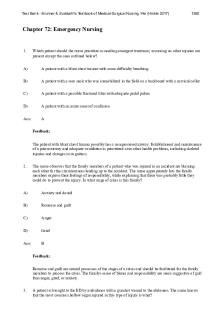CH 72 Glucocorticoids Keypoints Nursing Implications PDF

| Title | CH 72 Glucocorticoids Keypoints Nursing Implications |
|---|---|
| Course | Pharmacology 2 |
| Institution | Imperial Valley College |
| Pages | 4 |
| File Size | 148.1 KB |
| File Type | |
| Total Downloads | 75 |
| Total Views | 155 |
Summary
Key points and nursing implication...
Description
CHAPTER 72 NON-ENDOCRINE USES OF GLUCOCORTICOIDS Key Points
▪ Glucocorticoids are used in low (physiologic) doses to treat endocrine disorders and in high (pharmacologic) doses to treat nonendocrine disorders (e.g., arthritis, asthma).
▪ Glucocorticoids are beneficial in nonendocrine disorders primarily because they suppress inflammatory and immune responses.
▪ Glucocorticoids produce their effects by penetrating the cell membrane and activating cytoplasmic receptors, which then travel to the cell nucleus, where they modulate the activity of genes that code for specific regulatory proteins.
▪ Glucocorticoids reduce inflammation by multiple mechanisms, including suppressing the (1) synthesis of inflammatory mediators (prostaglandins, leukotrienes, histamine), (2) infiltration of phagocytes, (3) release of lysosomal enzymes, and (4) proliferation of lymphocytes.
▪ Important nonendocrine indications for glucocorticoids include arthritis, allergic disorders, asthma, cancer, and suppression of allograft rejection.
▪ When used in pharmacologic doses, especially for prolonged times, glucocorticoids can cause severe adverse effects. These are not seen at physiologic doses.
▪ Adverse effects of the glucocorticoids include adrenal insufficiency, osteoporosis, increased vulnerability to infection, muscle wasting, thinning of the skin, fluid and electrolyte imbalance, glucose intolerance, psychologic disturbances, and peptic ulcer disease.
▪ By causing potassium loss, glucocorticoids can increase the risk for toxicity from digoxin, and they can exacerbate hypokalemia caused by thiazide and loop diuretics.
▪ Concurrent use of NSAIDs with glucocorticoids increases the risk for peptic ulcer disease.
▪ Prolonged glucocorticoid use causes adrenal insufficiency.
▪ Patients with adrenal insufficiency must be given higher doses of glucocorticoids at times of stress (e.g., surgery, trauma). Failure to do so may be fatal!
▪ To minimize expression of adrenal insufficiency when glucocorticoids are discontinued, doses should be tapered very gradually.
▪ Following glucocorticoid withdrawal, supplemental glucocorticoids are needed at times of stress until adrenal function has fully recovered.
▪ Alternate-day dosing can help minimize development of adrenal insufficiency.
▪ Glucocorticoids should be administered before 9:00 AM to help minimize adrenal insufficiency and to mimic the burst of glucocorticoids released naturally by the adrenal glands each morning.
Summary of Major Nursing Implications
a
Glucocorticoids
Betamethasone Cortisone Dexamethasone Hydrocortisone Methylprednisolone Prednisolone Prednisone Triamcinolone
The nursing implications here apply to all glucocorticoids, but only to their use for nonendocrine disorders. Implications that apply specifically to their use for replacement therapy are discussed in Chapter 60. Implications specific to asthma therapy are discussed in Chapter 76.
Preadministration Assessment Therapeutic Goal Glucocorticoids are used to suppress rejection of organ transplants and to treat a variety of inflammatory, allergic, and neoplastic disorders. When treating inflammatory and allergic disorders, the goal is to suppress signs and symptoms to an acceptable level, not to eliminate them.
Baseline Data Make a full assessment of the specific disorder (e.g., rheumatoid arthritis, asthma, psoriasis) being treated. These data are used to determine the initial dosage and to guide dosage adjustments as treatment proceeds. Document baseline blood pressure and weight. Determine bone mineral density if therapy will be prolonged. Plot height on children to assess for delayed growth. Also, for prolonged or high-dose therapy, check serum glucose, electrolytes, and a complete blood count. Following prolonged treatment, hypothalamic-pituitary-adrenal (HPA) axis suppression may be assessed with an ACTH stimulation test and by plasma or urine cortisol testing.
Identifying High-Risk Patients Glucocorticoids are contraindicated for patients with systemic fungal infections and for individuals receiving live virus vaccines. Use glucocorticoids with caution in pediatric patients and in women who are pregnant or breast-feeding. In addition, exercise caution in patients with hypertension, open-angle glaucoma, heart failure, renal impairment, esophagitis, gastritis, peptic ulcer disease, myasthenia gravis, diabetes mellitus, osteoporosis, and infections that are resistant to treatment, and in patients receiving potassium-depleting diuretics, digoxin, insulin, oral hypoglycemics, or NSAIDs. When these drugs are necessary, dosage adjustments may be required.
Implementation: Administration and Dosage Routes and Administration Glucocorticoids are administered orally, parenterally (IV, IM, subQ), topically (to skin and mucous membranes), intranasally, by inhalation, and by local injection (e.g., intra-articular, intralesional). Routes for specific preparations are shown in Table 72.2. (Glucocorticoids administered topically, intranasally, and by inhalation are presented in Chapters 105, 77, and 76, respectively.) When getting ready to administer a glucocorticoid, verify that the preparation is appropriate for the intended route.
Dosage Dosage is determined empirically. For patients whose disorder does not threaten life, dosage should be low initially and then gradually increased, until the desired response is achieved. For a life-threatening disorder, initial doses should be as large as needed to control symptoms. During prolonged therapy, the dosage should be reduced to the smallest effective amount. Supplemental doses are needed at times of stress, unless the dosage is very high to begin with.
Alternate-Day Therapy Alternate-day dosing reduces adrenal suppression and other toxicities. Instruct patients to take their glucocorticoid medicine before 9:00 AM every other day.
Drug Withdrawal Glucocorticoids taken chronically must be withdrawn gradually. Warn the patient against abrupt discontinuation of treatment. After termination, supplemental doses are needed during times of stress until adrenal function has recovered fully.
Ongoing Evaluation and Interventions Evaluating Therapeutic Effects Evaluate therapy by making periodic comparisons of current signs and symptoms with the pretreatment assessment. Dosage adjustment is based on these evaluations.
Minimizing Adverse Effects General Measures. First, keep the dosage as low as possible and the duration of treatment as short as possible. Second, use alternate-day therapy if possible. Third, when appropriate, administer glucocorticoids topically, intranasally, by inhalation, or by local injection, rather than systemically. Adrenal Insufficiency.
Long-term therapy suppresses the ability of the adrenal glands to make glucocorticoids. Increase the dosage when stress occurs (e.g., surgery, trauma, infection) unless the dosage is very high to begin with. After termination of therapy, supplemental doses are required at times of stress until adrenal recovery is complete. Advise the patient to carry identification (e.g., Medic Alert bracelet) to ensure proper dosing in emergencies. Advise the patient to always have an emergency supply of glucocorticoids on hand. Expression of adrenal insufficiency can be reduced by withdrawing glucocorticoids gradually. Adrenal insufficiency can be minimized through alternate-day dosing and the use of glucocorticoids that have an intermediate duration of action. Osteoporosis. Glucocorticoid-induced osteoporosis predisposes the patient to fractures, especially of the ribs and vertebrae. Monitor patients for signs of compression fractures (neck or back pain) and for indications of other fractures. Evaluate status with bone densitometry. Several drugs can help prevent osteoporosis. Important among these are calcium supplements, vitamin D supplements, thiazide diuretics (combined with salt restriction), bisphosphonates (e.g., risedronate, zoledronate), teriparatide, and calcitonin. Estrogen therapy can reduce bone loss in postmenopausal women, but the benefits are not likely to outweigh the risks. Infection. Glucocorticoids increase the risk for morbidity from infection. Warn patients to avoid close contact with persons who have a communicable disease. Inform patients about early signs of infection (e.g., fever, sore throat), and instruct them to notify the prescriber if these occur. Treat established infections with appropriate antimicrobial drugs, and withdraw glucocorticoids unless they are absolutely required. Glucose Intolerance. Glucocorticoids can cause hyperglycemia and glycosuria. Patients with diabetes may need to decrease their caloric intake and use higher doses of hypoglycemic medication (insulin or an oral hypoglycemic). Fluid and Electrolyte Disturbance. Glucocorticoids can cause sodium and water retention and loss of potassium. These effects can be minimized by (1) using glucocorticoids that have low mineralocorticoid activity, (2) restricting sodium intake, and (3) taking potassium supplements or consuming potassium-rich foods (e.g., bananas, citrus fruits). Educate patients about signs and symptoms of fluid retention (e.g., weight gain, swelling of the lower extremities) and hypokalemia (e.g., muscle weakness, irregular pulses, cramping), and instruct them to notify the prescriber if these develop. Growth Delay. Glucocorticoids can suppress growth in children. Evaluate growth by making periodic measurements of height and weight. Alternate-day therapy minimizes effects on growth. Cataracts and Glaucoma. Cataracts are a common complication of long-term therapy. Open-angle glaucoma may also develop. The patient should be given an eye examination every 6 months. Instruct the patient to notify the prescriber if vision becomes cloudy or blurred. Peptic Ulcer Disease. Glucocorticoids may increase the risk for ulcer formation and can mask ulcer symptoms. Instruct the patient to notify the prescriber if stools become black and tarry. Have stools checked periodically for occult blood. If ulcers develop, glucocorticoids should be slowly withdrawn—unless their continued use is considered essential for life—and antiulcer therapy should be instituted. Psychologic Disturbances. Systemic glucocorticoids can cause psychologic disturbances, both mild (insomnia, anxiety, agitation, irritability) and severe (delirium, hallucinations, depression, euphoria, mania). Depression is more likely with low-dose, long-term therapy, whereas psychoses (mania, delirium) are more likely with high-dose, short-term therapy. Psychologic disturbances are reversible and usually resolve within days to weeks after drug withdrawal. Depression may respond to a mood stabilizer (e.g., carbamazepine, valproic acid) or a selective serotonin reuptake inhibitor (e.g., fluoxetine [Prozac]). Psychotic symptoms may respond to an atypical antipsychotic. Inform patients about possible psychologic reactions, and instruct them to report disturbing symptoms. Monitor for suicidal ideation. Use in Pregnancy and Lactation. Glucocorticoids can induce adrenal hypoplasia in the developing fetus. When large doses have been employed, the newborn should be assessed for adrenal insufficiency and given replacement therapy if indicated. During high-dose therapy, the glucocorticoid content of breast milk may become high enough to affect the nursing infant. Warn women who are receiving high-dose therapy not to breast-feed. Other Adverse Effects. Myopathy and Cushing's syndrome can be minimized by implementing the general measures noted at the beginning of this section. There are no specific measures to prevent these complications.
Minimizing Adverse Interactions
Interactions Related to Potassium Loss. Glucocorticoid-induced potassium loss can be augmented by potassium-depleting diuretics (thiazides, loop diuretics) and can increase the risk for toxicity from digoxin. If digoxin and glucocorticoids are used concurrently, potassium levels should be monitored. Also, be alert for indications of cardiotoxicity. Nonsteroidal Anti-Inflammatory Drugs. NSAIDs can increase the risk for gastric ulceration during glucocorticoid therapy. Exercise caution when this combination is employed. Insulin and Other Hypoglycemics. Glucocorticoids can elevate blood levels of glucose. Diabetic patients may need to increase their dosage of insulin or other hypoglycemic drugs. Vaccines. Glucocorticoids can decrease antibody responses to vaccines and can increase the risk for infection from live virus vaccines. Immunization should not be done while glucocorticoids are in use. a
Patient education information is highlighted as blue text....
Similar Free PDFs

Exam 2 nursing implications
- 11 Pages

Ch 72 - Test bank
- 18 Pages

Emergency Nursing Chapter 72- for RN
- 47 Pages

ATI Rationales Keypoints
- 4 Pages

Keypoints deel 18
- 7 Pages

La regola del 72
- 10 Pages

Catullo Carmi 8, 72
- 5 Pages

Lezione 9 - Appunti 72
- 3 Pages

CH 12 Antepartum Nursing Notes
- 13 Pages

Implications for Strategy
- 1 Pages
Popular Institutions
- Tinajero National High School - Annex
- Politeknik Caltex Riau
- Yokohama City University
- SGT University
- University of Al-Qadisiyah
- Divine Word College of Vigan
- Techniek College Rotterdam
- Universidade de Santiago
- Universiti Teknologi MARA Cawangan Johor Kampus Pasir Gudang
- Poltekkes Kemenkes Yogyakarta
- Baguio City National High School
- Colegio san marcos
- preparatoria uno
- Centro de Bachillerato Tecnológico Industrial y de Servicios No. 107
- Dalian Maritime University
- Quang Trung Secondary School
- Colegio Tecnológico en Informática
- Corporación Regional de Educación Superior
- Grupo CEDVA
- Dar Al Uloom University
- Centro de Estudios Preuniversitarios de la Universidad Nacional de Ingeniería
- 上智大学
- Aakash International School, Nuna Majara
- San Felipe Neri Catholic School
- Kang Chiao International School - New Taipei City
- Misamis Occidental National High School
- Institución Educativa Escuela Normal Juan Ladrilleros
- Kolehiyo ng Pantukan
- Batanes State College
- Instituto Continental
- Sekolah Menengah Kejuruan Kesehatan Kaltara (Tarakan)
- Colegio de La Inmaculada Concepcion - Cebu





